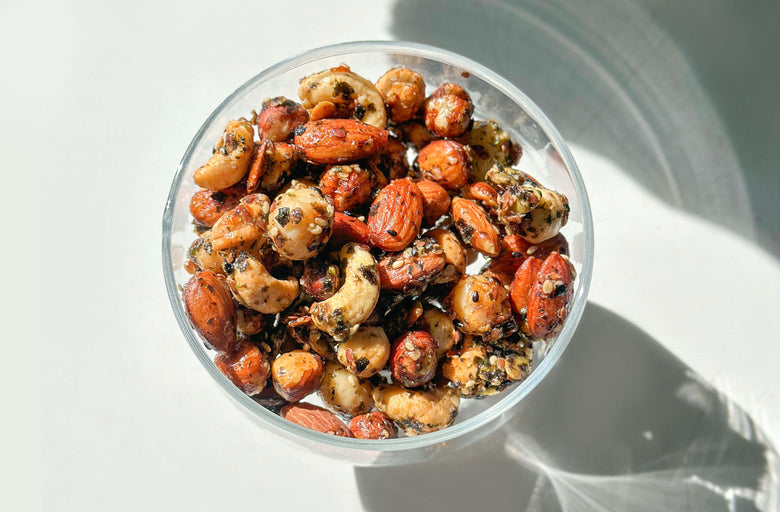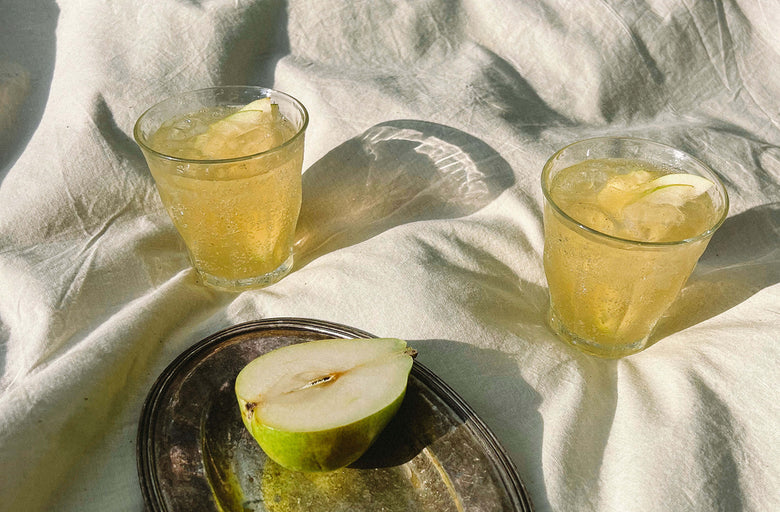With the recent news of America’s growers having to ditch perfectly good harvests, fresh, life-giving food has never been more precious. We continue to be wowed and inspired by the Sakara kitchens and all they do to create lovingly-prepared, organic, plant-rich meals. Our chef-led teams have heightened respect for each fresh, organic ingredient that arrives from our farmers and suppliers. This bounty drives them to get creative— maximizing the green quota in each meal, using every square inch of prep and cook space smartly and working toward our ongoing Zero Waste initiative, part of our larger sustainability efforts (which you can learn more about here). Our culinary teams leave no stone unturned when it comes to repurposing, recently partnering with a company that takes our avocado pits and transforms them into a dye for textiles.
With Earth Day coinciding at a moment where we are spending increased time in the kitchen, we asked our Sakara Culinary Director Tyler Harvey and Sakara Wellness Coach and avid plant home cook, Sasha Pagni to share some enlightened ideas for cutting food waste, along with clever hacks and tips for organizing a cooking space to lessen impact while amping up flavor and taste.
Lesson 1: Keep It Fresher, Longer
Before you even lift a knife, ensure you are storing foods smartly, so everything you buy stays fresher, longer.
- When purchasing greens (especially soft lettuces), store them in a container with paper towels on the bottom and top to keep them moist but not soggy. If your container creates a barrier between the greens and any excess water (Pagni uses this greensaver), they can last safely for weeks.
- Store ingredients and cooked food in clear containers, so it’s easy and quick to see what’s inside. (Harvey likes glass or BPA-free plastic.)
- Use masking tape and permanent marker to label containers with the name of the contents and the date. Store items with the labels facing out so you can see what’s what. When reusing your containers, simply remove the tape and make a new label.
- After trimming herbs like parsley or cilantro, store them in a glass jar with a little bit of water at the bottom and cover the leaves with a reusable bag.
- Decant your dry goods like flours, beans, rice, seeds, and nuts to glass jars to save space and create an airtight seal. You can take containers to the bulk foods section of your store to refill, cutting down on packaging.
-
Cut down on the use of plastic bags at the grocery store. Instead of using the single-use plastic produce bags they offer, source cloth/mesh bags that can be used and washed thousands of times. (Check with your grocery store that they allow reusable bags.)
Lesson 2: Use Your Fridge and Freezer
These helpful allies are already in your kitchen and are great tools to help you extend the life of your fruit, veg, herbs, and more.
- Keep nuts in your fridge. Harvey says it helps keep them fresher longer, which means you can buy in bulk without feeling pressured to use up right away.
-
Fill ice-cube trays with chopped herbs. Oregano, thyme, rosemary, and sage can be used in soups, and mint and tarragon are wonderful in an herbal iced tea.
(We also love this idea for freezing herbs in olive oil.) - Harvey says you can freeze almost anything. If it is frozen properly, it stays fresh.
Here are a few helpful reminders:
*Make sure anything you freeze is room temperature or colder
*Use an airtight and well-sealed container to avoid freezer burn. Harvey uses sturdy freezer Ziplocs, labeling and dating them with a marker and tape so she can remove them, wash, and reuse.)
*Freeze one of our favorite good fats. Here’s how.
Lesson 3: Use It All
Wilting lettuce? Leftover broccoli stems? These “throw-away” plants can find new life in surprising, delicious ways. Find out how to maximize every bit of your produce.
- For veggies that are about to go off, Harvey suggests using them to make sauces like salsa verdes (filled with blitzed greens and herbs), romesco (made up of nightshades like bell peppers, tomatoes or eggplant), and flavored hummus or bean dips (butternut squash makes a great base). The fat and acid in each helps these sauces hold up longer in the fridge, and they can be easily frozen as well.
- Make a pesto out of just about anything. Carrot top pesto, avocado pesto, broccoli stem pesto, spinach pesto...just add any nuts or seeds you have on hand (such as hemp or pumpkin seeds), nutritional yeast, salt, pepper, and a squeeze of lemon.
- Trying to get rid of those two-week-old, slightly droopy radishes in the back of the fridge? Whip up quick pickles. Slice the vegetables thinly and toss with salt and vinegar. They are delicious on a veggie sandwich or as a garnish on a rice bowl. Or try our easy fermented vegetable recipe.
- Leftover broccoli stalks or cauliflower stems chopped into rounds are great ways to add extra fiber to your stir fry or smoothie.
- Regenerate your most-used vegetables, like romaine lettuce or spring onions, by soaking them in water.
- Whip up homemade breadcrumbs to simultaneously use up stale bread and make any pasta or salad tastier. Harvey says the key is to add flavor. The following all work well: everything bagel spice, garlic, minced herbs, or chili oil. The recipe is simple: Rip up the leftover bread you have and dry it out in a low heat oven (200 F) for an hour or so until it's golden brown. Transfer to a food processor with seasoning and blitz until you have crumbs. (If you don’t have a processor, place bread in a sealed plastic bag and smash it with a rolling pin or even a book.) Store in a jar and use to top anything you wish. It lasts for weeks.
- If you buy olive oil in a tin, create a puncture in the top by the pouring spout to allow it to drain out fully and avoid any air pockets.
- Save seeds from squash or the root bulbs from onions and regrow them by sprouting them and replanting them in a small container.
- Save citrus peels and submerge them in vinegar to make an all-purpose cleaner.
Lesson 4: Give Back
- To Others: If you are helping out a neighbor in need with a food donation, consider frozen foods. Harvey says while people might shy away from giving frozen food, it's the safest (in terms of food safety) way to gift food, because there's no risk of bacterial growth, and someone can eat it on their own timeline. Some of her favorite food gifts are salad dressings or sauces that someone can use in different ways over a long period of time. You can also donate ingredients you don’t use to organizations that give them new life through cooking or composting. Sakara kitchens partner with City Harvest, Roho Compost and Wilenta Feed to ensure nothing goes to waste.
- To Mother Earth: Keep a compost bin under your sink or by your trash can. You can also store compost bags of food in the freezer, as Harvey does. Your local farmer’s market usually accepts compost, so you can drop it off while shopping. Harvey says even composting a little is better than not composting at all. Start small with what feels manageable to you. We like this stylish, small-space friendly bin.
More Earth-Friendly Ideas






